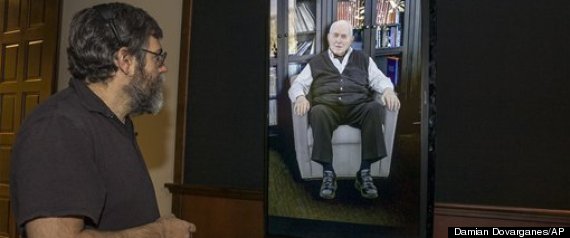 |
| "USC is creating holograms of aging Holocaust survivors telling their stories." |
By John Rogers
The Huffington Post, February 2, 2013
"For years, Holocaust survivor Pinchus Gutter has told the tragic story of watching his parents and 10-year-old twin sister herded into a Nazi death camp's gas chambers so quickly that he had no time to even say goodbye. He was left instead with an enduring image he has carried with him through 70 years: that of his sister vanishing into a sea of people doomed to die. Only this time the elderly, balding man wasn't really there as he recounted the horror of the Holocaust to an audience gathered in an auditorium at the University of Southern California's School of Cinematic Arts. It was the 80-year-old survivor's digital doppelganger, dressed in a white shirt, dark pants and matching vest, that was doing the talking as it gazed intently at its audience, sometimes tapping its feet as it paused to consider a question. Over the years, elderly Holocaust survivors like Gutter have been leaving behind manuscripts and oral histories of their lives, fearful that once they are gone there will be no one to explain the horror they lived through or to challenge the accounts of Holocaust deniers like Iranian President Mahmoud Ahmadinejad. For the past 18 months, a group led by USC's Shoah Foundation has been trying to change that by creating three-dimensional holograms of nearly a dozen people who survived Nazi Germany's systematic extermination of 6 million Jews during World War II.
Like the digital librarian portrayed by Orlando Jones in the 2002 movie 'The Time Machine,' the plan is for Gutter and the others to live on in perpetuity, telling generations not born yet the horror they witnessed and offering their thoughts on how to avoid having one of history's darkest moments repeated. Although people at this week's event saw Gutter as only a two-dimensional figure, he has been painstakingly filmed for hours in 3-D and, perhaps as early as next year according to those involved in the project, his hologram could be talking face-to-face with visitors at the U.S. Holocaust Memorial Museum in Washington, DC. Certainly it will be within five years, said Stephen Smith, the Shoah Foundation's executive director, and Paul Debevec, associate director of the university's Institute for Creative Technologies, which is creating the hologram project's infrastructure. 'Having actually put it together, it's clear this will happen,' said Debevec, whose institute has partnered with Hollywood on such films as 'Avatar' and 'The Curious Case of Benjamin Button,' winning a special Academy Award for the latter. Indeed, it already has almost happened. More than 15 years after his death, rapper Tupac Shakur made a 3-D hologram-like appearance at last year's Coachella Valley Music and Arts Festival, performing alongside a real Snoop Dogg. Technically, Shakur wasn't a hologram, however, because his image was projected onto a thin screen that was all but invisible to the audience. 'This takes it one step further as far as you won't be projecting onto a screen, you'll be projecting into space,' Smith said of the project, called New Dimensions in Testimony. It comes just in time, said Rabbi Marvin Hier, director of the Simon Wiesenthal Center, which is dedicated to keeping alive the history of the Holocaust. 'This generation is coming to an end, unfortunately,' Hier said of Holocaust survivors, whose average age is estimated at 79. 'Within the next decade or so there won't be many survivors alive anywhere in the world.' Given the prominence of Holocaust deniers like Iran's Ahmadinejad, Hier said, it's crucial to record survivors' accounts in a way that future generations can easily access and relate to. [...]"














No comments:
Post a Comment
Please be constructive in your comments. - AJ